
No one wants to talk about the Elephant in the room.
The first two DVDs of Cowboy Bebop feel almost eerily self-contained, considering that the show was produced only a couple of years after DVD technology was even invented. The five episodes on the first disc form a beautiful little arc all on their own. The second disc doesn’t quite have as much of a shape, but it still feels coherent, with all five episodes sharing the same theme (and to a large degree, the same tone). Alas, Disc three does not feel coherent at ALL. Toys in the Attic, far and away the silliest episode of Cowboy Bebop so far, serves as something like a summary coda for the thematic arc that started in disc two, giving us a chance to catch our breath before Jupiter Jazz, a sprawling two-parter that could have very easily been a stand-alone movie. And then there’s the last episode on the disc, Bohemian Rhapsody, which feels like they just stuck it in because there was space on the disc. Which they did. And that’s normal. The fact that these kinds of aesthetic questions can come up at all shows that Cowboy Bebop is a little smarter than the average bear: when you watch TV on DVD, how often do you spare a moment’s thought for how the episodes are spaced out over the discs? I don’t either, usually… but something about Bebop invites this kind of analysis. (It might just be a function of how perfectly that first disc peaks in the fifth episode: it feels so planned that it has you grasping at straws for the rest of the series). Anyway. Moving on. This time I tried to just work the analysis in with the plot summaries. If you preferred the old format, let me know in the comments and I’ll switch it back for next time.
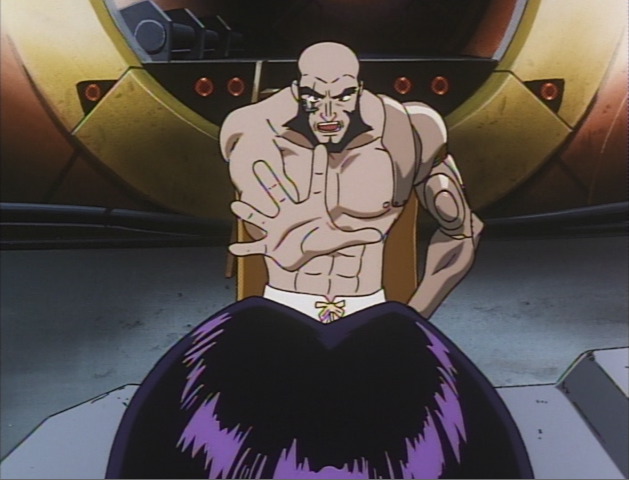
Stop! In the naaaame of looove
11) In Toys In The Attic, we find the Bebop floating through deep space on its way to Mars. The crew hasn’t had any work in weeks, so they’re a little bit broke, and a whole lot stir-crazy. The episode beings with Faye literally beating the pants off of Jet at poker (see above), while Spike tries to grill kebabs with a flamethrower. (The kebab sequence is a pretty cute joke, and it doubles as a convenient way to establish that, hey, they have a flamethrower on board. I wonder if that’ll come in handy?) Jet wanders off to the cargo bay to find a blanket and sulk, where he sees a mysterious refrigerator, and is bitten by a mysterious alien blob monster. Spike tries to help him with some traditional medicine, but it, uh… it does not go so well.
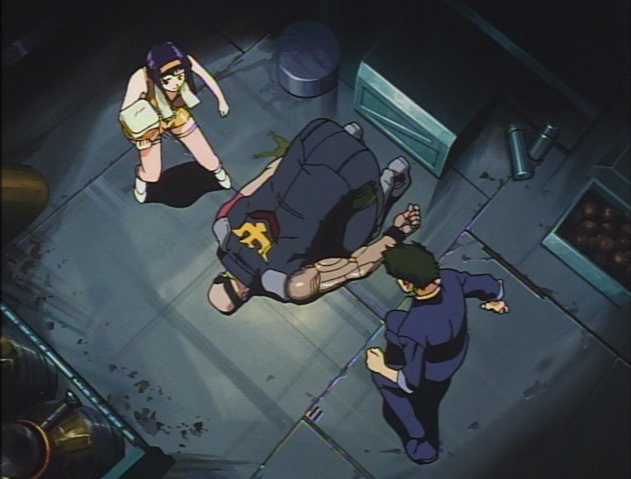
The bulk of the episode plays out pretty predictably. The blob monster picks off the members of the crew one at a time, until Spike is the only one left. He gears up, flamethrower in tow, and climbs into the air ducts to go hunt the thing. But the plot takes a hard left turn into crazytown at the end, because Spike loses. You think that he’s killed the monster, but in true horror movie form it jumps back up and bites him, which we’ve been given to understand is probably fatal unless treated. And since everyone else has already lapsed into alien-venom induced comas… yeah. This episode ends with a Total Party Kill. The “Next Time, On Cowboy Bebop:” sequence at the end even starts out with Ed saying “And so they all died. It’s very sad, but what can you do? This was the last episode of Cowboy Bebop,” before the other cast members break in and shout her down. (The “Next Time, on…” sequences have been played pretty straight up until this episode, but later in the series they go batpoop insane. Later on, we’ll come across an episode where the teaser trailer is basically “Next week, on Cowboy Bebop: a thrilling search for… ahh, who are we kidding. The story never really goes anywhere. I’d skip it, if I were you.” And then there’s one where it starts off with Jet saying “I’m tired of doing these voiceovers. Here, Ein, you give it a shot,” followed by twenty seconds of barking.)
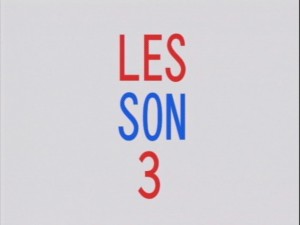 Much like these teaser trailers, Toys in the Attic is very ridiculous. In fact, it’s almost fractally ridiculous, by which I mean it is silly on many interlocking levels. It is, first of all, a parody of the movie Alien, and while Cowboy Bebop has referenced all sorts of movies in pretty much every episode, this is the first out-and-out parody. So that’s pretty ridiculous. Second, the episode is broken up into four “lessons,” separated by title cards (pictured left), in which each character takes a turn providing voiceover narration and a moral to the story. Jet narrates the opening up until the monster bites him, then Faye narrates until it bites her, and then Ed, and finally Spike. This kicky formalist conceit would already be ridiculous in a French New Wave kind of way, but it’s pushed to new heights of ridculosity by morals themselves, which range from deadly serious (Jet, who more or less says “Hubris is clobbered by Nemesis”), to the amoral (Faye, whose big lesson is “Put yourself first and don’t trust anyone”), to the surreal (Ed, who breaks the 4th wall in her narration – “Lesson? Lesson? What lesson?” – before settling on “If you see a stranger, follow them,”), to the… well, we’ll get back to Spike’s moral in a bit. And also silly is the scene where Spike takes a time out from fighting the space alien to try to light a cigarette with his flamethrower, which is one of the most priceless bits of comic business I’ve ever seen comitted to film.
Much like these teaser trailers, Toys in the Attic is very ridiculous. In fact, it’s almost fractally ridiculous, by which I mean it is silly on many interlocking levels. It is, first of all, a parody of the movie Alien, and while Cowboy Bebop has referenced all sorts of movies in pretty much every episode, this is the first out-and-out parody. So that’s pretty ridiculous. Second, the episode is broken up into four “lessons,” separated by title cards (pictured left), in which each character takes a turn providing voiceover narration and a moral to the story. Jet narrates the opening up until the monster bites him, then Faye narrates until it bites her, and then Ed, and finally Spike. This kicky formalist conceit would already be ridiculous in a French New Wave kind of way, but it’s pushed to new heights of ridculosity by morals themselves, which range from deadly serious (Jet, who more or less says “Hubris is clobbered by Nemesis”), to the amoral (Faye, whose big lesson is “Put yourself first and don’t trust anyone”), to the surreal (Ed, who breaks the 4th wall in her narration – “Lesson? Lesson? What lesson?” – before settling on “If you see a stranger, follow them,”), to the… well, we’ll get back to Spike’s moral in a bit. And also silly is the scene where Spike takes a time out from fighting the space alien to try to light a cigarette with his flamethrower, which is one of the most priceless bits of comic business I’ve ever seen comitted to film.
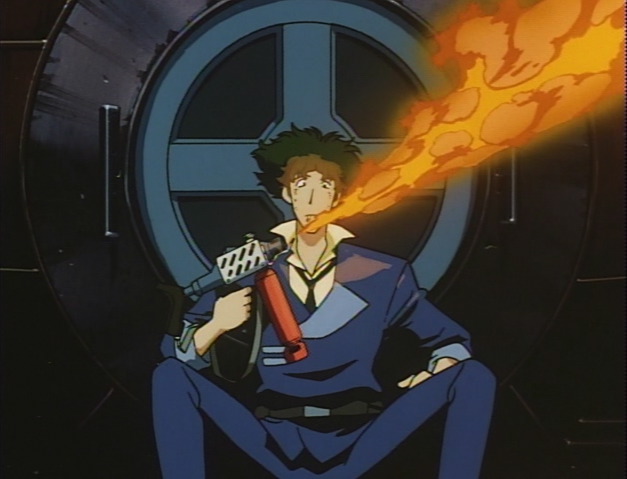
But just when you’ve been lulled in a sense of security, suddenly… look out! Behind you!
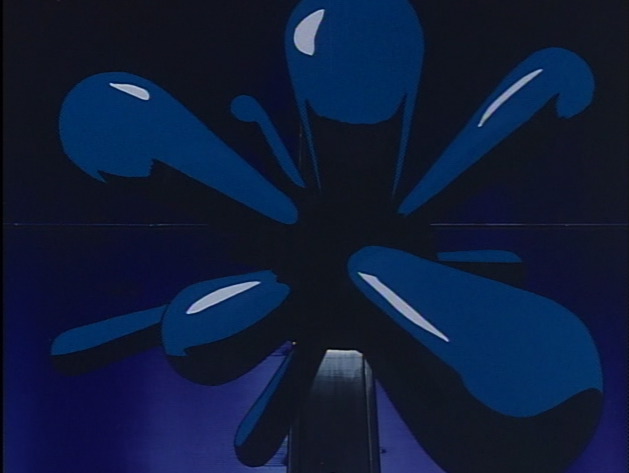
Boogah boogah boogah! H.R. Giger eat your heart out.
The great thing about the Alien parody is that, in the midst of all this sillyness, it is played brutally straight. The monster is creepy, yo. The picture above doesn’t do the thing justice… no still image could, because the horror is in how they animate it. Its shape, mass and volume don’t seem to stay the same from frame to frame. It comes off as – dare I say it? – non-Euclidian. The more specific references to the original movie aren’t played as jokes either. There aren’t any face-full-of-alien-wing-wong comments, or anything… it’s just a monster loose in the air ducts, and a dude chasing it with a flamethrower, and a motion detector, and ventilation fans, and a creepy monster-POV cam, and the crew getting picked off one by one, and the monster slowly spinning out into space at the end.
So the only real joke in this very spooky episode is how note-perfect it is… until the huge, colossal joke at the end where we learn – and those of you who have seen the episode know that I’ve been kind of dancing around this – the monster’s origin. We’ve had various theories on this throughout the episode. Is it a rat? A mutant rat? A monster from the depths of space? Finally, we learn the horrible truth: Spike stashed some lobster in the back of the fridge over a year ago, and forgot to clean it out. The result? A poisonous mutant space lobster running amok in the crawl space. And Spike’s moral, of course, is “DON’T… LEAVE… FOOD… IN… THE… FRIDGE!!!” I almost expected a cameo from J. Walter Weatherman. This retroactively infects everything in the episode – if not the entire series – with near-toxic levels of sillyness. And it’s far and away my favorite moment in the series so far.

The Horror. Note the hint of lobster red on the left hand side of the screen. And be glad that smell-o-vision (or in your case, the smellnternet), never quite got off the ground.
After that, things just get sillier. As the tainted fridge flies off into space, we’re treated to a rapturous, swooning montage set to Tchaikovsky’s Waltz of the Flowers. (This is the second time that music from The Nutcracker has turned up on the show, the first being at the end of Jamming With Edward, also a notably silly episode. Not really sure what’s going on there.) The montage has some great, almost Eisensteinian, juxtaposition of images… it’s completely gratuitous, but then, it’s always been my contention that the best parts of Cowboy Bebop are the utterly gratuitous set-pieces. This is just the first time that the gratuitous set-piece was lyrical instead of bad-ass. Check out how every one of these shots seems to be layed out around a single axis of rotation. There are even moments where the “spokes” on the wheel – Ein’s body, the fridge’s glitter trail, etc. – seem to be rotating between shots like the hands of a clock.
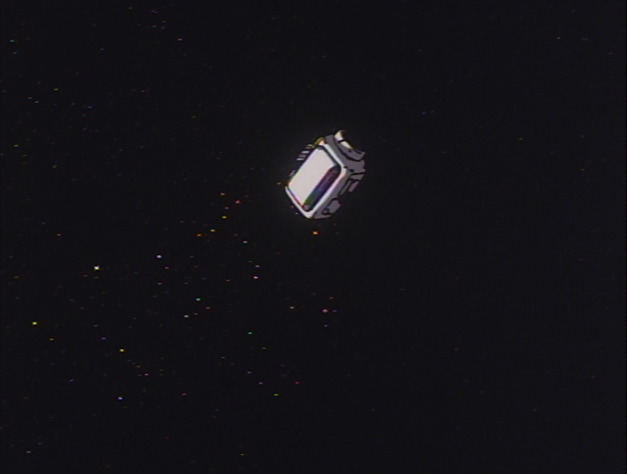
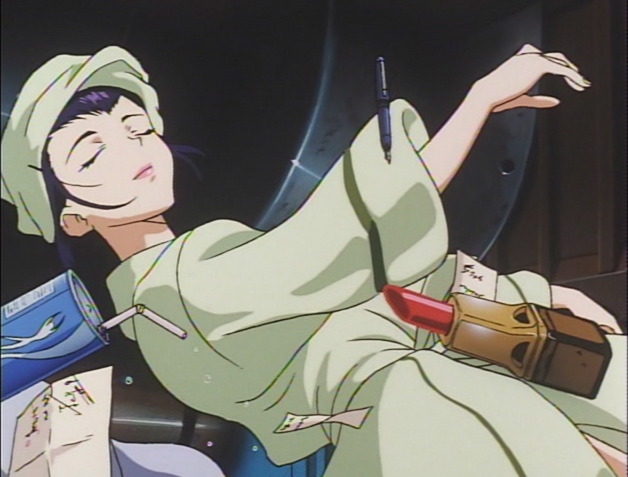
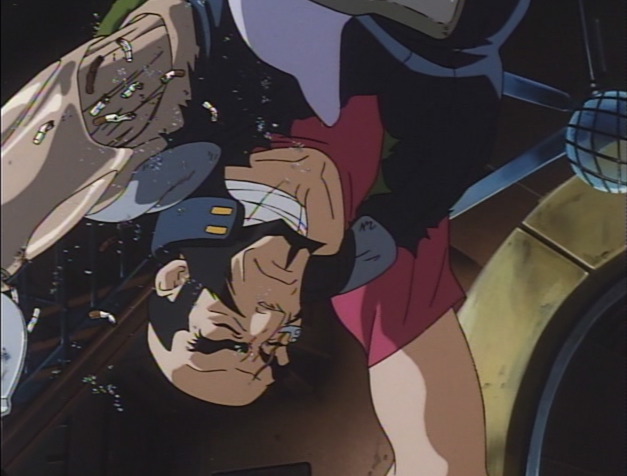
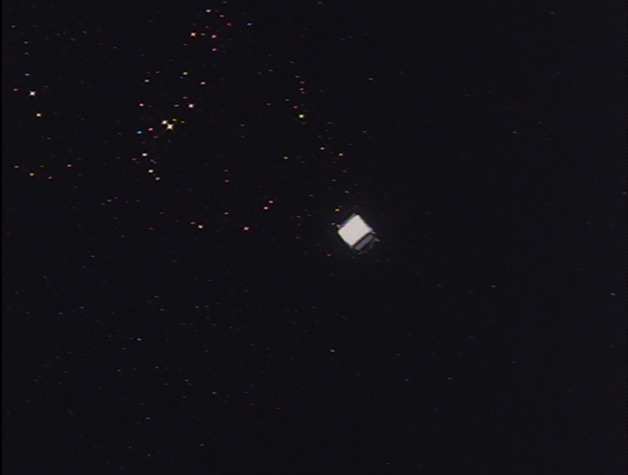
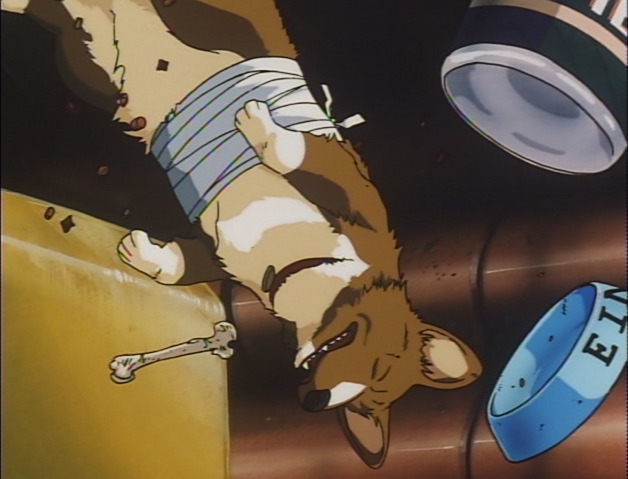

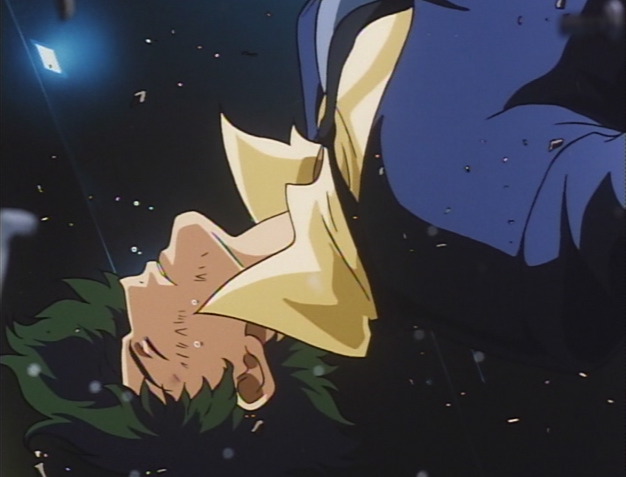
And then at the very end, Ed – who possibly was never bitten after all, but just wandered off and fell asleep somewhere – absentmindedly grabs the monster up off the floor and eats it. Which struck me as a lot more messed up than it probably should have, but hey, I guess a free lobster is a free lobster.
Silly as it is, there’s a lot going on under the hood here, because the “lessons,” inappropriate as they are, do tell you a lot about the characters. What Jet actually says is that man has to earn his living through hard work, and that whenever people try to get rich quick, they are punished by fate for their greed and laziness. I remember reading somewhere that film-noir and pulp fiction heroes make a fetish of professionalism, clinging to the protestant work-ethic when all other moral codes have failed… and this is very much the kind of guy that Jet is. In several other episodes, people bring up his old police nickname, “The Black Dog who bites once and never lets go.” Which is honestly kind of cumbersome for a nickname, but we’ll let that slide: the point is that he’s the kind of guy who keeps his word, even if it means that he winds up naked and shivering in the cargo hold of his own spaceship.
Faye’s moral is equally revealing. Having watched quite a couple of discs ahead while I was writing about Choose Your Own Adventure books, I can tell you that Faye is the character who arcs the most over the course of the series from here on out. Which is an interesting choice on the writers’ part, but never mind that for now. What’s important is that her arc basically starts here: she doesn’t let people get close because she’s been hurt in the past. We’ll see how that begins to change starting in the very next episode, where she pulls a runner because she’s afraid of how attached she’s getting to Spike.
Ed’s moral is probably just meant to be surreal. But maybe not. So far, the only reason we’ve been given for her even wanting to be on the BeBop is that… well, for some reason she really wanted to come. “If you see a stranger, follow them,” is actually the most character development that we’ve had for her. Now, I don’t know if I would have ever come up with this next bit if I wasn’t trying to read deeper meaning into the episode. But maybe she was just lonely? A kid who has no family, so she follows the next stranger she sees in the hope that they will become her family? It’s at least plausible.
And then there’s Spike. Like I said, “Toys in the Attic” is a thematic coda to the episodes collected on the previous disc, which – if you remember – were all about how past trauma, and past sins, will always come back and bite you in the ass. “DON’T… LEAVE… FOOD… IN… THE… FRIDGE!” I don’t need to explain the metaphor, right? Yeah, I probably don’t need to explain the metaphor.
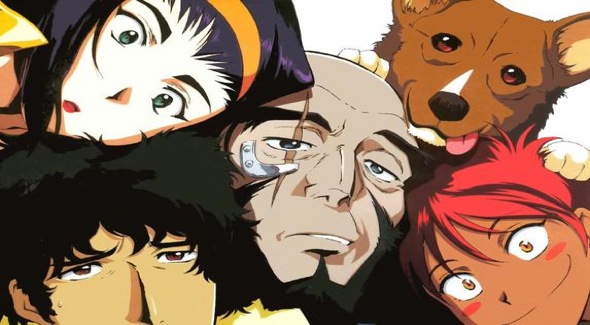
Ed’s 4th wall-breaking and her dubious lesson in Toys in the Attic is a lot more revealing to her worldview: she’s completely disconnected from reality. There are no consequences in Ed’s mind.
There’s a lot of assumption on the writer’s part for Jupiter Jazz. They assume we have figured out what makes these characters tick and I’ll give you my thoughts on the matter
Being bounty hunters, Ed would be skimming underground sites and bounty hunter websites that deal in rumors and criminal sightings. With Julia’s name coming up (despite being a common name), Spike would still react to it because of where it came up: the criminal underbelly of the solar system. That makes, at least in my opinion, Jet and Spike’s argument all the more poignant. Jet assumes that Spike is going chase after his past. The last time he did that, we got Spike the Mummy and Jet’s willing to bet that Spike will be coming back in a body bag. However, I can’t explain how Faye ended up in the same moon as the Julia rumor (and ultimately Spike) other than plot convience. Nor can I explain why they just let Faye back on the ship despite how much she screwed them.
Faye’s actions inside Gren’s apartment are also pretty explainable if you follow Miss Valentine’s modus operandi for (most) of the series: money. Gren was/is close friends with Vicious, as evidenced by the pictures Gren has of the two in uniform. Vicious is the leader of the Red Dragons, a premiere organized crime syndicate. Gren’s in the shower alone, unarmed and possibly with a nice bounty on his head. I believe I can see the dollar signs in Faye’s eyes. She is flirty with Gren and shows some attraction to him but now it’s business. I imagine all the alcohol she’s consumed in the last 12 hours also influenced her decision making.
Faye’s reaction to the reveal of Gren’s intersexed condition is a well done. She was attracted to what she was classify as a woman. She isn’t exactly pleased with this revelation and doesn’t really know how to react to it (I imagine the booze isn’t helping either). Once she finds out Gren’s past, her prior plan doesn’t really work as Gren doesn’t have a bounty and there’s no guarantee that Faye could even get to Vicious now. I’m also sure she’s sobering up and her plan isn’t as great as she first imagined it.
having read all 4 of your posts, i now feel qualified to comment. i would have written some comments on the other articles, but apparently i am too late. you make some really interesting points and comparisons, but you seem to ignore one critical aspect of cowboy bebep. which is this: it is anime. i don’t know if this was touched on in the past, or assumed, or deliberately ignored, but some of your observations and comments could be answered by the fact that this series is a product of a foreign pop culture. and there are certain aspects of that culture that explain some peculiarities of the series, most notably, the animation. the long panning shots of static backgrounds and images are a staple of anime, not because of artistic license, but because they save money. the same could be said about weird character movements, strange visuals such as the fruit flying over ein in episode 2, and the reuse of establishing shots like the bebop pulling into a warp gate, which i know you haven’t mentioned. and while i know the music was innovative for an anime series at the time, the choices aren’t necessarily as deliberate as you might think. Yoko Kanno composed hundreds of songs and themes for the show before the animation went into production and Watanabe or whoever the shot caller was picked and chose what to use for any particular scene or episode. that is why there are 5(?) soundtracks for the show that have a ton of songs that you may not recognize or possibly have never heard. no one knew how popular cowboy bebop was going to be until it started to be popular, after production had already ended on the core series, and so it was produced in the japanese anime tradition: haphazardly. in fact, if i remember correctly, it never aired in its entirety in japan until after it started to gain popularity in america. at the time, it was really just Watanabe’s low budget love letter to american culture.
maybe your analysis of the series is purposefully ignorant of the intentions of the creators of the series, i don’t know. but basically what i’m getting at is this: like all anime, it has to be viewed through the lens of our cultural differences and translation problems before it really starts to make sense. there are some points where you touched on that, like jet’s weird arm gestures and the translation problems at the end of episode 10, but i feel that you are taking too small a scope on its impact on the entire series.
side note: i am endlessly amused by your nod to the tick. and here i thought i was the only one.
@marmls2m I don’t think that’s a valid criticism of Mr. Stokes’ analysis. Yes, something is lost in the translation and there is a culture gap between American and Japanese audiences. It does lead to some references and direction that leaves us curious (like the character design influences and the fruit flying), it does not immediately exclude us from understanding the themes and the narrative value of the show. The show stands on its own and can freely be criticized by the masses regardless of whether we understand every single minituae of the show.
You also gloss over the fact that Cowboy Bebop was not show in its entirety in both Japan and the US until it was very popular as it crossed Japanese and US cultural taboos. The first episode wasn’t cleared for air in Japan as it featured prominent drug use. The US had 2 episodes cut (episodes 6 and 8?) because it featured violence against children and a plane hijacking shortly after 9/11. There’s also an episode that featured the WTC but I can’t remember if they trimmed the scene out or if they cut the whole episode during the first few runs.
cowboy funk. cut out of its run on adult swim either the first or second time, i cant remember.
@marmls2m
Good points, but also, restrictions breed creativity. If circumstances, budget or genre force you to use a certain technique or make something a certain way, it’s better to make it work on your own terms than to just let it happen.
For example, _Paranormal Activity_ is the way that it is because it was shot on a super-low budget. But the aesthetic choices are also deliberate and have other purposes.
@Riderlon –
Yeah, to a certain degree I’m being uncharitable about the plot holes just because it makes for a funnier article. And you’re absolutely right about *why* Jet gets in an argument with Spike (although it doesn’t make the way their argument is carried out any less strange). I disagree with you about Faye’s motivation for drawing down on Gren though – I don’t think it’s supposed to be money, I think she wants revenge on Vicious for Spike or for herself.
@marmlst2m – “maybe your analysis of the series is purposefully ignorant of the intentions of the creators” Yeah, that’s the one. I always try to avoid learning anything about the creator’s artistic vision until I’ve drawn my own conclusions about the work itself. Especially when I’m dealing with something like film or TV, where pinning down one creator is often borderline impossible. I don’t mean to say that this is the “right” way to analyze a show, but for me doing it the other way is kind of paralyzing.
As for the music “not being deliberate,” while I freely acknowledge that I have no idea who assigned which track to play under which scene, someone made the choice. I usually assign that agency to the composer for the sake of convenience, but even if it turns out to have been left up to some lowly production intern, I’m sure that whoever it was said “Wow, placing the music! Here’s my chance to shine!” and did the best job they could do.
Your criticism that I should approach this with more of a background in anime is harder for me to answer, because I probably should. There’s always room for multiple perspectives, as Riderlon points out, and I like to think that includes the perspective of a genre neophyte like myself. But it IS usually better to be able to put the work in context with its genre. Let me ask you, (and Riderlon, I’d love you to weigh in on this as well, because from the earlier comment threads you seemed to be well-informed): what aspects of Cowboy Bebop are generically required? That is, are there some parts of the show that are so common in anime – specifically action/sci-fi anime – that they don’t even bear commenting on? I can think of one example right off the top of my head (Spike’s green hair), but I’m sure there are others that I’m not seeing.
(Keep it spoiler free please, though – I still want to approach the rest of the show without preconceived notions.)
just off the top of my head, i would say translation is a really big issue. like almost all anime, the english voice actors were really hamming it up and pretty much butchered most of the dialogue. my favorite example of this is in episode 3, honky tonk woman, in the exchange between faye and spike at the blackjack table.
(i am going completely from memory here)
english subtitles:
“i am not nimble, nor am i lucky”
“what are you?”
“generous”
english sound track:
“i’m not skillfull and i’m not really lucky either”
“what are you then?”
“well, i seem to be very generous”
what is a simple, graceful, elegant, and well written exchange becomes a pop up book level display of the awful translation job. that is not to say the subtitles are totally perfect either. let me just say that my japanese friend had much more criticism for the english dialogue then i did.
the second thing i can think of right now is fan service, which explains faye’s ridiculous outfit and the amount of coverage seemingly dedicated till faye’s boobs (just wait till you see the movie). fan service is pretty much an inescapable aspect of any anime aimed at an audience over grade school age. while there are some shows that do avoid fan service, like full metal alchemist, they often fall into other trappings of anime, like silly rage attacks and deliberatly poor animation.
i would also like to point out that i feel ed’s personality to be pretty irrelevent to the series, as he/she does have a tendancy to break the 4th wall, and no one in the show really pays that much attention to her insanity. it is just my personal opinion that ed was just kind of shoved into the show with little regard for how it would affect the greater story or their other, better fleshed out characters. ed seems to be there only for comic relief, and only, it seems, in moments and episodes where it has no effect on the story or general mood.
@stokes I’m glad you consider me an expert. I think I have too much time and disposable income.
Cowboy Bebop hits a few things that you as a self processed neophyte would probably miss: Spike, Jet and Faye’s character designs are homages to the cast of Lupin III, which is a series that’s been (essentially) running since the 70s. The hair color thing is just to make characters more memorable and diversify the cast. I’m trying to think of some specific examples but it’s been ages since I sat down and watched Cowboy Bebop.
@marmls2m You make it sound as if the English translators either go out of their way to ruin dialogue or that they’re totally incompetent at their jobs. Citing the example you use as a way the English dialogue was inferior. They have to match the dialogue to the lip movements. The exchange between Spike and Faye still conveys the same information and the code talk (from Faye’s perspective)/flirty tone (Spike’s perspective) but loses a little bit of that “elegance” as you put it. You also seem to fail to realize that the Japanese companies have a pretty large part in the translation and voice selection process. The English scripts and the cuts of the dialogue will not go anywhere until the Japanese studio (Bandai, in this case) approves it.
The problem of translation is not specific to anime, of course, but Cowboy Bebop is an interesting case. Most of the differences between the dub and the subtitles are like the one marmls2m points out, where the dubbed version is slicker, more verbose, more conversational, etc. And I agree that this is annoying. However, very rarely, there will be a really substantive change. And in these cases, I sometimes find myself preferring the dub. For instance, there’s a throwaway scene in one episode (Ganymede Elegy, I think), where Faye spends a little time working on her tan. Ed asks her why she’s doing it. Here’s her reply, according to the subtitles:
“Beautiful skin requires constant effort that seems futile,”
and the dub:
“Beautiful skin requires constant effort that is ultimately futile.” [emphasis mine]
Just a small change, but there’s a world of difference between them. The dubbed version presents a character that is complex, ironic but resigned, vain but self-aware, and generally interesting</em. The subbed version comes off as vain and conceited, and that's about it.
Now, I generally assume that the subtitles are closer to the original Japanese, per lectio difficilior. But does that make them better, necessarily? Or should translators feel free to improve the original whenever they get the chance? Obviously the problem with this second tactic is that a lot of the improvements end up being “improvements” instead. But there are some cases where they actually are better… and I find that these put me in an uncomfortable position. I don’t know how to judge them, honestly.
>.
(Better late than never.)
Not that anyone cares, but, although I’m usually a big proponent of subtitles, where Bebop is concerned, I prefer the dub, primarily for the reasons Stokes outlined above. (Although maybe it’s just ’cause I’m sick of hearing Megumi Hayashibara’s voice, I don’t know.)
anime dubs have been getting much better lately, with the rise of anime’s popularity in the us. pre-2000 no one really gave a crap about the english dub, which explains how the atrocious dub of envangelion happened.
I find your analysis interesting, yet I believe it fails in its mention of the LGBT part of the episode. Gren never changed his “gender” and it wasn’t inflicted upon him, if anything was inflicted upon Gren, it was the gynecomastia that he suffers from. That is all. If anything, I think the portrayal of LGBT characters is interesting in this episode as Gren casually admits that he is homosexual and it is not played in a gag in a 1998 anime. I guess my comment is a bit too late, but still.
For Toys in the attic, I always saw it as a dream that Ed was having. (Which would explain the ridiculousness of the episode) Towards the beginning of the episode she’s asleep and you hear her mutter, “I can’t eat anymore” At the end she says the same thing.